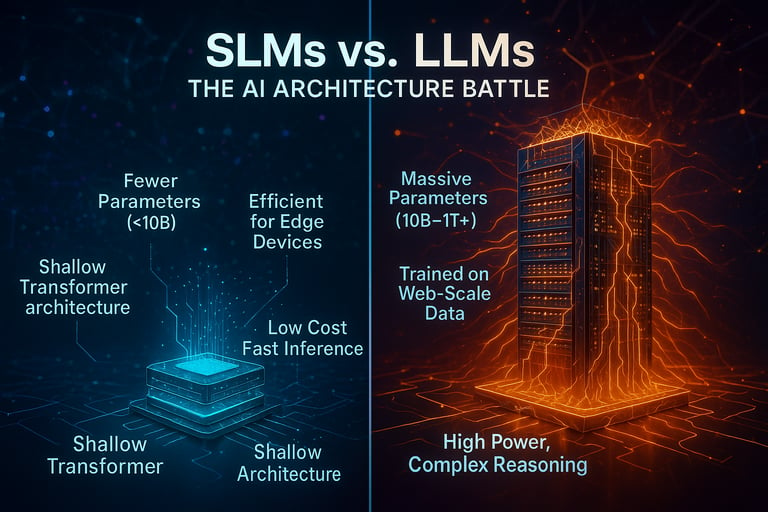🔥 Unlock AI-Driven Growth
Trusted AI consultants with 25+ years of expertise in Strategy & Automation
The Architecture Battle - SLM vs LLM
In the rapidly evolving AI landscape, the debate between Specialized Language Models (SLMs) and Large Language Models (LLMs) is reshaping enterprise adoption. This article breaks down their architectural differences, cost-performance trade-offs, and real-world applications—helping you choose the right AI backbone for your business needs. Key Takeaways: ✅ When to use SLMs (efficiency, domain-specific tasks) vs LLMs (generalization, creativity) ✅ Hidden costs: Training, inference, and maintenance compared ✅ Future outlook: Will hybrid architectures dominate? For AI leaders, builders, and decision-makers—cut through the hype with actionable insights.
CORE AI & TECHNOLOGY
Rajeev Sharma, Founder | CEO - BhuviAI
7/19/20252 min read


The architectural differences between Small Language Models (SLMs) and Large Language Models (LLMs) primarily revolve around model size, computational requirements, training data, and use-case optimizations. Below is a detailed breakdown of their key distinctions:
1. Model Size & Parameters
SLMs (Small Language Models)
Typically have fewer than 10 billion parameters (often in the millions to low billions).
Examples:
Microsoft's Phi-1.5 (1.3B parameters)
Google’s Gemma-2B (2B parameters)
Meta’s Llama 2-7B (7B parameters)
Designed to be lightweight, making them suitable for edge devices (phones, IoT) or low-resource environments.
LLMs (Large Language Models)
Usually have tens to hundreds of billions of parameters (or even trillions for frontier models).
Examples:
OpenAI’s GPT-4 (~1.8T parameters rumored)
Google’s Gemini 1.5 (up to ~1T parameters)
Meta’s Llama 3-70B (70B parameters)
Built for high-performance tasks requiring deep reasoning, long-context understanding, and complex generation.
2. Training Data & Pretraining
SLMs
Trained on smaller, curated datasets (sometimes synthetic or high-quality filtered data).
Often use knowledge distillation (training smaller models to mimic larger ones).
Example: Microsoft’s Phi-3 was trained on "textbook-quality" synthetic data for efficiency.
LLMs
Trained on massive, diverse datasets (often petabytes of internet text).
Use web-scale scraping (CommonCrawl, GitHub, books, etc.).
Benefit from self-supervised learning (predicting next token in a sentence).
3. Architectural Optimizations
(A) Model Depth & Width
SLMs
Fewer layers (e.g., 12–24 transformer layers) and narrower hidden dimensions.
Use efficient attention mechanisms (e.g., sliding window attention, sparse attention).
Example: Mistral-7B uses grouped-query attention (GQA) for faster inference.
LLMs
Deeper networks (e.g., 60–120+ transformer layers) with wide hidden states (e.g., 8192+ dimensions).
Use dense attention (full self-attention) or mixture-of-experts (MoE) (e.g., GPT-4).
(B) Memory & Compute Efficiency
SLMs
Optimized for low-memory footprint (can run on CPUs or mobile GPUs).
Use quantization (e.g., 4-bit or 8-bit weights) for efficiency.
Example: Phi-2 runs efficiently on a single GPU.
LLMs
Require high-end GPUs/TPUs (e.g., H100 clusters) for training/inference.
Use model parallelism (tensor/pipeline parallelism) to distribute workload.
4. Use Cases & Deployment
SLMs
Edge AI: On-device chatbots (e.g., Microsoft’s Phi-3 for smartphones).
Specialized tasks: Code completion (StarCoder 3B), medical QA.
Cost-effective inference: Lower latency, cheaper API costs.
LLMs
General-purpose AI: ChatGPT, Claude, Gemini.
Complex reasoning: Advanced math, legal analysis, long-form writing.
Enterprise applications: Custom fine-tuning for big corporations.
5. Fine-Tuning & Adaptability
SLMs
Easier to fine-tune on small, domain-specific datasets.
Used in federated learning (privacy-preserving training on edge devices).
LLMs
Require massive compute for fine-tuning (LoRA, QLoRA help reduce cost).
Often fine-tuned via reinforcement learning from human feedback (RLHF).
6. Performance Trade-offs
Feature level differentiations
Parameters : SLMs < 10 B | LLMs > 10B–1T+
Training Data : Smaller, curated | Web-scale, diverse
Hardware : CPUs, mobile GPUs | GPU/TPU clusters
Latency : Low (real-time) | High (requires batching)
Accuracy : Good for narrow tasks | SOTA in general tasks
Cost : Cheap to run | Expensive API/cloud costs
Conclusion
SLMs are optimized for efficiency, speed, and edge deployment, sacrificing some generality.
LLMs prioritize maximum capability but require heavy infrastructure.
Trend: Hybrid approaches (e.g., Mixture-of-Experts, quantization) are blurring the lines between SLMs and LLMs.
🔗 About BhuviAI
At BhuviAI Solutions, we specialize in building scalable, open-source-driven AI toolchains and agent-based solutions. This visualization is part of our effort to make AI more explainable, composable, and usable across industries.
For collaboration or advisory inquiries, reach out at;
📧 mail us at info@bhuviai.com
📲 call us at +91 99719 38001
🌐 visit us at www.bhuviai.com
